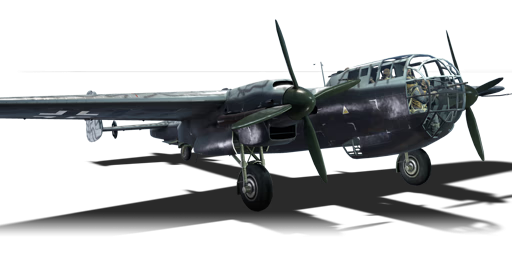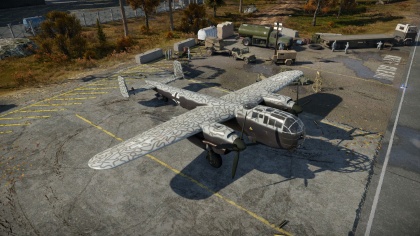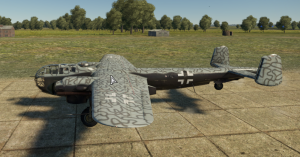Do 217 M-1
Contents
| This page is about the German bomber Do 217 M-1. For other versions, see Do 217 (Family). |
Description
The Do 217 M-1 is a rank IV German bomber
with a battle rating of 5.3 (AB), 4.7 (RB), and 5.7 (SB). It was introduced in Update 1.29.
General info
Flight performance
Describe how the aircraft behaves in the air. Speed, manoeuvrability, acceleration and allowable loads - these are the most important characteristics of the vehicle.
| Characteristics | |||||||
|---|---|---|---|---|---|---|---|
| Stock | |||||||
| Max Speed (km/h at 5,700 m) |
Max altitude (meters) |
Turn time (seconds) |
Rate of climb (meters/second) |
Take-off run (meters) | |||
| AB | RB | AB | RB | AB | RB | ||
| 533 | 520 | 10000 | 31.2 | 32.3 | 7.8 | 7.8 | 800 |
| Upgraded | |||||||
| Max Speed (km/h at 5,700 m) |
Max altitude (meters) |
Turn time (seconds) |
Rate of climb (meters/second) |
Take-off run (meters) | |||
| AB | RB | AB | RB | AB | RB | ||
| 588 | 560 | 10000 | 28.8 | 30.0 | 12.7 | 10 | 800 |
Details
| Features | ||||
|---|---|---|---|---|
| Combat flaps | Take-off flaps | Landing flaps | Air brakes | Arrestor gear |
| X | ✓ | ✓ | X | X |
| Limits | ||||
|---|---|---|---|---|
| Wing-break speed (km/h) |
Gear limit (km/h) |
Combat flaps (km/h) |
Max Static G | |
| + | - | |||
| 380 | ~8 | ~6 | ||
| Optimal velocities | |||
|---|---|---|---|
| Ailerons (km/h) |
Rudder (km/h) |
Elevators (km/h) |
Radiator (km/h) |
| < 290 | < 360 | < 360 | > 311 |
| Compressor (RB/SB) | ||
|---|---|---|
| Setting 1 | ||
| Optimal altitude | 100% Engine power | WEP Engine power |
| 5,300 m | 1,510 hp | 1,665 hp |
Survivability and armour
- 8.5 mm Steel plates behind the pilot.
- 8.5 mm Steel plates in front of dorsal gunner.
- 5 mm Steel plate under ventral gunner.
- 8.5 mm Steel plate in front of ventral gunner.
- 8.5 mm steel on top of engines
Armaments
Suspended armament
The Do 217 M-1 can be outfitted with the following ordnance:
- 4 x 250 kg SC250JA bombs (1,000 kg total)
- 26 x 50 kg SC50JA bombs (1,300 kg total)
- 8 x 250 kg SC250JA bombs (2,000 kg total)
- 2 x 500 kg SC500K bombs + 2 x 250 kg SC250JA bombs (1,500 kg total)
- 4 x 500 kg SC500K bombs (2,000 kg total)
- 2 x 1,000 kg SC1000L2 bombs (2,000 kg total)
- 4 x 1,000 kg SC1000L2 bombs (4,000 kg total)
- 2 x F5W torpedoes
Defensive armament
The Do 217 M-1 is defended by:
- 1 x 13 mm MG 131 machine gun, nose turret (1,000 rpg)
- 1 x 13 mm MG 131 machine gun, dorsal turret (500 rpg)
- 1 x 13 mm MG 131 machine gun, ventral turret (1,000 rpg)
- 1 x 7.92 mm MG 81 machine gun, 2 x front beam turret (750 rpg)
Usage in battles
Flying the Do 217 M-1
In October 1945 British Captain Eric Brown undertook full handling trials with a Do 217 M-1 WNr 56158 at RAF Farnborough. He recalled a distinctly "underwhelming" experience. Brown recalled that he took off with full power of some 2,700 rpm and the lightly loaded Do 217M left the runway at 160 km/h (99 mph). Brown held a shallow climb, waiting to reach 200 km/h (120 mph) before retracting the undercarriage. Brown timed the time it took to retract, which was between 30 and 40 seconds. At 150 m (490 ft) he reduced power to 2,500 rpm and raised the flaps at about 230 km/h (140 mph). With the flaps up a climbing speed of 230 km/h (140 mph) was established giving a rate of "very moderate proportions".
While in cruising mode, Brown took the Dornier to 5,500 m (18,000 ft) and with the tail at +2 degrees angle of incidence, gave it a top speed of 523 km/h (325 mph), true air speed. Brown stated the aircraft was very stable about all three axes, and the controls were well harmonised and effective, and not unduly heavy for bomber operations. At the other end of the speed range, stall occurred at 154 km/h (96 mph), and was characterised by a gentle nose-down pitch. At this stage Brown tried the Dornier's single-engine performance and this "proved decidedly unimpressive". It underlined that the aircraft was underpowered. Above 1,500 m (4,900 ft), height could not be maintained at 2,300 rpm and its ceiling was barely 7,600 m (24,900 ft). Brown reverted to "normal power", and decided to "chance his arm" (risk) on a dive-bombing procedure in what he described as a "ponderous aeroplane". Brown made a straight dive to 700 km/h (430 mph), the maximum permitted below 3,000 m (9,800 ft) in order to get a feel for the controls, which began to stiffen considerably. The engine revolutions built to 2,750 during the dive causing a lot of noise. Brown pulled the aircraft out of its dive though it called for a "good full-blooded heave" on the control column.
After climbing to regain the height lost, Brown decided to test the tail-mounted, clamshell-like dive brake and automatic pull-out equipment. The Dornier entered the dive automatically when the dive switch was selected and soon attained its "braked condition", limiting the airspeed to 575 km/h (357 mph). The pull-out was initiated by hitting the bomb-release stick on the control column or selecting the "level flight" switch, which also retracted the dive-brake. Brown stated, "All very sedate and totally unimpressive as a precision weapon".
The landing procedure began at an air speed of 250 km/h (160 mph). The oil coolers were opened fully and the radiator hatches opened to 30 degrees. At 240 km/h (150 mph) the undercarriage was lowered, which again took 30 to 40 seconds. Flaps were lowered to their start position at 235 km/h (146 mph) and fully deployed at 220 km/h (140 mph). The tail had to be trimmed to 4 degrees incidence (tail heavy). Final approach was made at 200 km/h (120 mph) and touchdown occurred at about 160 km/h (99 mph). Landing weight was roughly 13,000 kg (29,000 lb). The control column had to be held back beyond the neutral to keep the tail wheel locked until the landing run was complete.
Source: https://en.wikipedia.org/wiki/Dornier_Do_217#cite_note-German_military_archive,_Freiburg-2
Manual Engine Control
| MEC elements | ||||||
|---|---|---|---|---|---|---|
| Mixer | Pitch | Radiator | Supercharger | Turbocharger | ||
| Oil | Water | Type | ||||
| Not controllable | Controllable Auto control available |
Not controllable Not auto controlled |
Controllable Not auto controlled |
Combined | Not controllable 1 gear |
Not controllable |
Modules
| Tier | Flight performance | Survivability | Weaponry | ||
|---|---|---|---|---|---|
| I | Fuselage repair | Radiator | Turret 7 mm | ITC PVC I | |
| II | Compressor | Airframe | New 7 mm MGs (turret) | ITC PVC II | |
| III | Wings repair | Engine | Turret 13 mm | ETC 2000/XII | |
| IV | Engine injection | Cover | New 13 mm MGs (turret) | ||
Pros and cons
Pros:
- Good payload (up to 4 x 1,000 kg)
- Quite fast and manoeuvrable for a bomber
- Can perform as both a level and dive bomber
- Very easy to fly and to land
- One of the bombers that can demolish a base (AB) or all three bases (RB/SB) with a single run
- Can be very difficult to catch once it reaches a high altitude
- Fast, with room to go even faster with upgrades installed and empty payload
- Airframe can withstand high speed
- Can be equipped with torpedoes
Cons:
- Poor defensive armament
- Very challenging to fly with only stock upgrades, with poor flight performance and disappointing payload
- Not very durable
- Carrying the 4,000 kg payload will add external pylons which will increase drag and reduce speed, flight performance, and climb rate
- Two of the SC1000L2s (externally-carried ones) drop at the same time in RB and SB
- Cramped cockpit and poor pilot protection
- Tail design creates a blind spot to the already underwhelming defensive armaments
History
The M-1 night bomber version, equivalent to Do 217 K-1 but with DB603A engines, carried similar armament and bomb load to K-1. Daimler-Benz DB 601s were also used on some variants to keep the airframes in service (the shortage of powerplants made this difficult). Mostly though, DB603A-1 engines were used on the M-1, its only major difference with the K series. The M-1/Umrüst-Bausätze 1 (abbreviated "/U1") incorporated the M defensive armament and the lattice air brake of the E-2. The MG 81Z and 131 were to be replaced by the MG 151 in the A-stand position. Problems with the air brakes prevented serial conversions. By November 1943 the M-1/U1 had matured into a night bomber with anti-glare protection in the cabin. The machine was equipped with a MG 131 in the nose, two MG 81Js in the cabin windows and two MG 131s in the B and C stand. Some M-1/U2s were fitted for deployment of German PGM guided ordnance with the required FuG 203d Kehl IV guidance transmitter, and rear-looking FuG 216 Neptun R radar equipment. 438 M-1 were built by Dornier in Munich and Wismar.
Source: https://en.wikipedia.org/wiki/Dornier_Do_217#cite_note-German_military_archive,_Freiburg-2
In-game description
Dornier Do 217 M-1 medium twin-engine bomber
The creation of the next version of the Do 217 bomber was caused by a shortage of BMW 801 air-cooled engines. These engines were urgently needed for Fw 190A fighters and Ju 88G heavy night fighters.
In order to avoid interruptions in the production of Do 217K bombers, the Dornier Flugzeugwerke designers quickly redesigned the Do 217 K-1 to enable the installation of DB 603 liquid-cooled engines. The DB 603A twelve-cylinder, in-line, liquid-cooled engine had a takeoff power of 1,750 hp and was equipped with a 3.72 m diameter four-bladed propeller.
Due to the new engine's higher fuel consumption, the Do 217M's flight range was reduced by about 150 km. Nevertheless, other flight characteristics of the new variant proved to be better than those of the Do 217K; for example, the plane's maximum flight speed was increased. However, even without its combat load, the aircraft could fly with one working engine only if it was descending.
The Do 217M's armament and bomb capacity were the same as the Do 217K's, but a large-calibre 13 mm Rheinmetall-Borsig MG 131 machine gun was installed in the nose-mounted turret instead of a twin 7,92 mm Mauser MG 81Z machine gun.
Some of the production machines were equipped with FuG 216 Neptun signals intelligence systems that operated in the rear hemisphere and were used to detect radar emissions from British night fighters. The FuG 216 device's antennas were mounted on the wing surfaces.
Aircraft with DB 603A and BMW 801D engines were produced simultaneously from 1942-43. The Do 217 M-1's production was discontinued in September 1943. A total of 443 Do 217 M-1 bombers were built. In 1944, 37 machines of the M-1 variant were converted to Do 217 M-11 guided weapon carriers.
In February 1944, the British managed to get one Do 217 M-1 with minimum damage. On the night of February 23, a bomber from the KG 2 squadron had been damaged by anti-aircraft gun fire over London. The crew immediately abandoned the machine, but the aircraft flew safely about 100 more kilometres and, by itself, landed on its belly near Cambridge.
Media
See also
Links to the articles on the War Thunder Wiki that you think will be useful for the reader, for example:
- reference to the series of the aircraft;
- links to approximate analogues of other nations and research trees.
External links
Aviation of World War II - http://www.airpages.ru/eng/lw/do217m.shtml
Aviation Safety Network - https://aviation-safety.net/wikibase/51052






